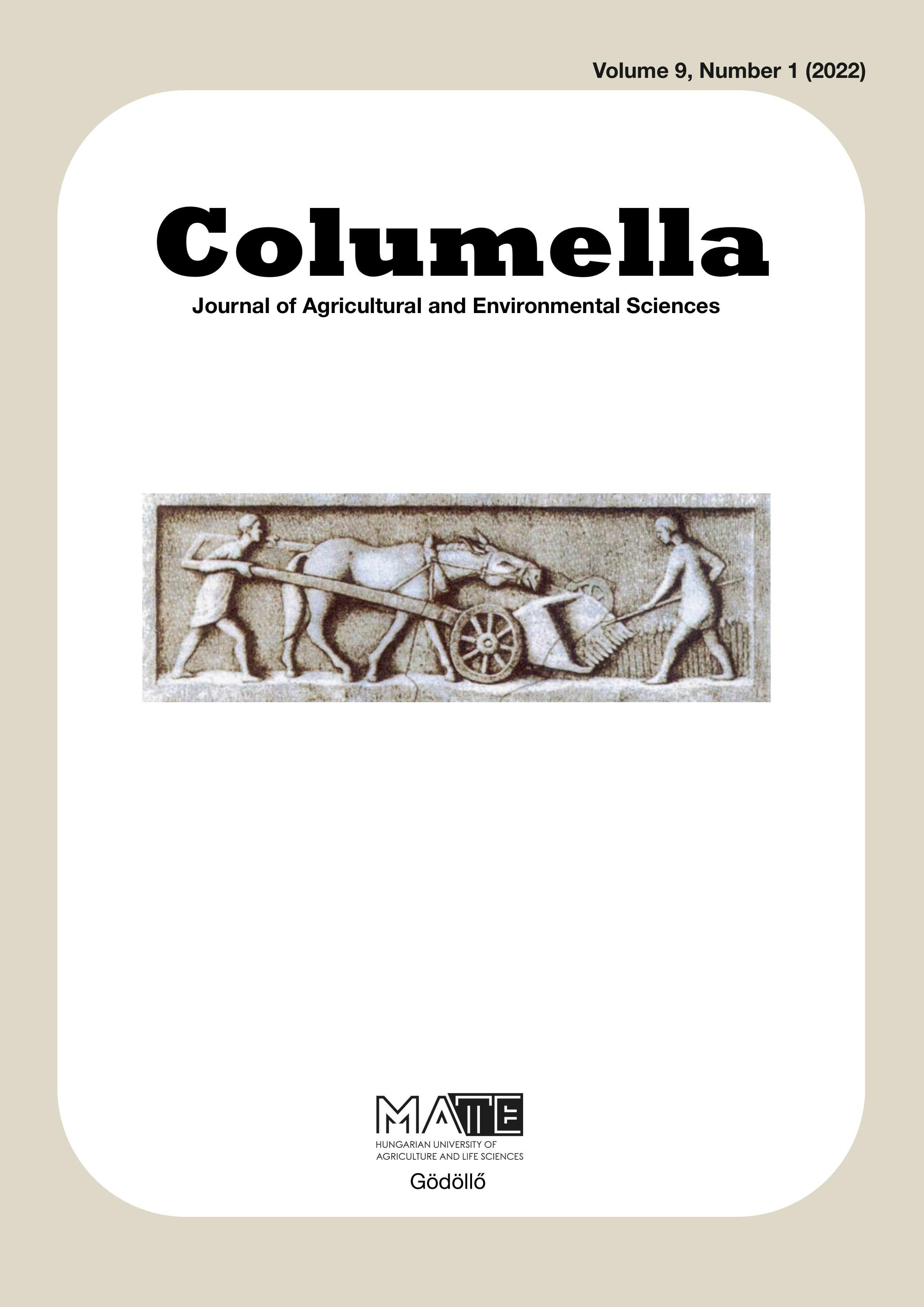GIS in the service of plant breeding in Karcag
DOI:
https://doi.org/10.18380/SZIE.COLUM.2022.9.1.57Keywords:
site-specific plant breeding, GIS methods, remote sensing, precision farming (PF), climate changeAbstract
Plant varieties bred by the Hungarian Breeding Institutes in different agro-ecological conditions can bear the unfavourable factors of the regions with greater tolerance, so they provide advantages and yield stability for the farmers who choose from these varieties. Farmers can contribute to the genetic potential of the planted seeds with the applied cultivation technology. The stable genetical background (the high quality pre- basic, basic and certified seeds) is provided by plant breeding to the farmers. Breeding is a long and tiring task: the classical breeding process, which usually takes 8–10 years, starts with selecting variety assignments and its growing. Finally new, stable varieties are produced which can provide balanced, high yield and also have good or significant qualitative features among extreme conditions. They can bear the unfavourable conditions of the region with greater tolerance, so provide significant yield stability for the farmers. Space technology supported IT solutions (remote sensing, precision farming and soil-friendly agro-technics) has been introduced into plant breeding methods in Karcag, which greatly support the aims of breeding. The main goal is to provide harmonical growing of the nursery, the large punctuality and to decrease the number and cost of agricultural operations. In this study, the new methods and technologies applied in plant breeding in Karcag are introduced.
References
Balla, L. (2010). Növénynemesítés és génmódosítás. Retrieved 21.02.2021, from https:// www.biokontroll.hu/novenynemesites-es-genmodositas/
Bedő, Z. (2004). A vetőmag születése. Budapest: Agroinform Kiadó.
Bedő, Z., & Láng, L. (2019). Fajtahasználat a magyar búzatermesztésben. GAZDÁLKODÁS: Scientific Journal on Agricultural Economics 63(4), 278–289.
Berényi, J., & Tánczné Óvári, C. (2018). Csökkenthető az aszálykár? AgroNapló 19(2), 17–18.
Braun, H. J., Ekiz, H., Eser, V., Keser, M., Ketata, H., Marcucci, G., Morgounov, A., & Zencirci, N. (1997). Breeding priorities of winter wheat programs. In H.-J. Braun, F. Altay, W. E. Kronstad, S. P. S. Beniwal, & A. McNab (Eds.), Wheat: Prospects for global improvement: Proceedings of the 5th international wheat conference, 10–14 june, 1996, ankara, turkey (pp. 553–560). Dordrecht: Springer Netherlands. doi: https://doi.org/10.1007/978-94-011-4896-2_72
Csurja, Zs. (2020). Precíziós, pontos és fontos: sok pénzt ér a helyes mérés. AgroNapló 21(2), 27.
Czimbalmos, Á. (2016). Az évjárat hatása az őszi búza egyes értékmérő tulajdonságaira a nagykunságban. (Unpublished doctoral dissertation). Debreceni Egyetem Kerpely Kálmán Doktori Iskola, Debrecen.
Czimbalmos, Á., Czimbalmos, R., Murányi, E., & Fazekas, É. (2019). A karcagi őszi árpa nemesítés eredményeiről, valamint a legújabb fajta (KG Nagykun) bemutatása. In Növénynemesítés a 21. század elején: kihívások és válaszok: XXV. Növénynemesítési Tudományos Nap (pp. 262– 265). Budapest: Magyar Tudományos Akadémia Agrártudományok Osztályának Növénynemesítési Tudományos Bizottsága.
Czimbalmos, R. (2017). Helyspecifikus gazdálkodás alkalmazásának tapasztalatai a forgatás nélküli művelésben karcagon. az elmélet és a gyakorlat találkozása a térinformatikában. Debrecen: Debrecen Egyetemi Kiadó.
Czimbalmos, R., & Kovács, G. (2017, November 16–17). Experiences of introduction of reduced tillage – an answer for the negative effect of climate change – and spreading in Jász-Nagykun-Szolnok county. In Ii east-west cohesion international conference (p. 22). Dunaújváros.
Czimbalmos, R., Kovács, G., & Tuba, G. (2017, October 5). Alacsony termelési költségeket és magas hozamokat biztosító új talajvédő művelési rendszer alkalmazásának tapasztalatai Karcagon. In Z. Futó (Ed.), Magyar vidék – perspektívák, megoldások a xx. században, i. vidékfejlesztési konferencia (pp. 54–59). Szarvas: Szent István Egyetemi Kiadó.
Gönczi, K. (n.d.). Lebutítható az okos farm a dolgozó szintjére? Így látják a termelők. Retrieved 21.02.2021, from https://www.agrarszektor.hu/noveny/lebutithato-az-okos-farm-a-dolgozo-szintjere-igy-latjak-a-termelok.19709.html
Harangi, A. (2017). Termésbecslés lehetőségének becslése LANDSAT 8 műholdfelvételek alapján. (Unpublished master’s thesis). DE MÉK Víz- és környezetgazdálkodási Intézet.
Heszky, L. (2008). A GMO kukoricahibridek termesztésénem előnyei és hátrányai. AgroNapló 4(1), 20–21.
Mátai, B. (2016). Éghajlatváltozás, megelőzés és alkalmazkodás. Budapest: Herman Ottó Intézet.
Mesterházi, P. (2018). A térinformatika és a geostatisztika szerepe a precíziós növénytermesztésben. Precíziós Gazdálkodás. Budapest: Agroinform Média Kft.
Popp, J. (2020). A fenntartható élelmiszerellátás kihívásai az élelmiszer/bioüzemanyag és a biodiverzitás/monokultúra kérdéseire kihegyezve. AgroNapló 21(2), 31–33.
Stefanovics, P., Filep, G., & Füleky, G. (1999). Talajtan. Budapest: Mezőgazda Kiadó. Szellő, G. (2018). Izgalmas 25 év, kihívásokkal teli jövő. Vetőmag 25(4), 6–7.
Takácsné, G. K. (2015). Agrárinnováció a gyakorlatban – avagy miért ilyen lassú a helyspecifikus növénytermelés terjedése? GAZDÁLKODÁS: Scientific Journal on Agricultural Economics 59(6), 517–526. doi: https://doi.org/10.22004/ag.econ.253790
Downloads
Published
Issue
Section
License
Copyright (c) 2022 Róbert Czimbalmos , Mónika Éva Fazekas, Eszter Murányi, Attila Nagy, Attila Harangi

This work is licensed under a Creative Commons Attribution-NonCommercial-NoDerivatives 4.0 International License.






